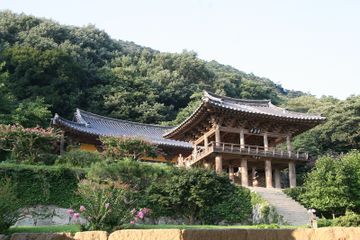"영주 부석사 안양루"의 두 판 사이의 차이
(→영문) |
|||
| 30번째 줄: | 30번째 줄: | ||
===영문=== | ===영문=== | ||
| + | '''Anyangnu Pavilion, Buseoksa Temple, Yeongju''' | ||
| + | Anyangnu Pavilion serves as the passage to Buseoksa Temple’s main worship hall Muryangsujeon. Usually, pavilions leading to a temple’s main worship area are aligned in a straight line '''facing the same direction'''. However, in order to harmoniously fit the building with the surrounding landscape, Anyangnu Pavilion was built slightly to the right off the main axis '''facing further south''' when compared to the position of the bell pavilion*. | ||
| + | The pavilion is considered a representative example of the 16th century’s temple pavilion architecture. It was built in 1576 after a single-story building, which originally stood on this site, burnt down in 1555. The pavilion’s lower floor consists of pillars and a staircase installed at the back leading up to Muryangsujeon Hall. The upper floor does not have any walls and features a wooden floor laid out in the traditional Korean parquet pattern. The plaque on the facade of the pavilion says Anyangmun, where ''anyang'', literally meaning “to have peace of mind and a rested body,” refers to the Western Paradise. | ||
| + | |||
| + | *Looking at the satellite images of the temple it doesn’t seem to be that much off the main axis. It doesn’t look like the bell pavilion is perfectly aligned with 천왕문too, for instance. It is mostly the fact that Anyangnu and Muryangsujeon are facing a different direction that is more noticeable. | ||
===영문 해설 내용=== | ===영문 해설 내용=== | ||
2023년 11월 29일 (수) 04:42 판
| 영주 부석사 안양루 |
|
 영주 부석사 안양루, 국가문화유산포털, 문화재청. |
|
| 대표명칭 | 영주 부석사 안양루 |
|---|---|
| 한자 | 榮州 浮石寺 安養樓 |
| 주소 | 경상북도 영주시 부석면 부석사로 345 |
| 지정번호 | 보물 |
| 지정일 | 2022년 10월 31일 |
| 분류 | 유적건조물 / 종교신앙 / 불교 / 각루 |
| 소유자 | 부석사 |
| 관리자 | 부석사 |
| 시대 | 조선시대 |
| 수량/면적 | 1동 / 85.31㎡ |
| 웹사이트 | 영주 부석사 안양루, 국가문화유산포털, 문화재청. |
해설문
국문
안양루는 부석사의 문루로 16세기 사찰 문루 건축물의 대표적 사례이다. 원래 ‘강운각(羌雲閣)’이라는 단층 건물이 있었으나, 명종 10년(1555)에 불에 타서 없어졌고, 이후 선조 9년(1576)에 그 자리에 중층으로 안양루를 지었다.
건물의 아래층은 모두 기둥으로만 구성되어 있으며, 가운데 칸에 계단을 두어 무량수전으로 향하는 누하진입의 형식으로 되어 있다. 극락왕생을 의미하는 안양문이라는 현판이 걸려 있다. 위층 사방은 벽체가 없이 트여 있으며, 내부 바닥 전체가 우물마루로 되어 있다.
일주문에서 무량수전에 이르는 사찰의 동선을 범종각과 안양루 구간에서 살짝 꺾어 무량수전 영역으로 진입하게 하고 있어, 조화로운 자연미를 극대화한 것이 특징이다.
영문
Anyangnu Pavilion, Buseoksa Temple, Yeongju
Anyangnu Pavilion serves as the passage to Buseoksa Temple’s main worship hall Muryangsujeon. Usually, pavilions leading to a temple’s main worship area are aligned in a straight line facing the same direction. However, in order to harmoniously fit the building with the surrounding landscape, Anyangnu Pavilion was built slightly to the right off the main axis facing further south when compared to the position of the bell pavilion*.
The pavilion is considered a representative example of the 16th century’s temple pavilion architecture. It was built in 1576 after a single-story building, which originally stood on this site, burnt down in 1555. The pavilion’s lower floor consists of pillars and a staircase installed at the back leading up to Muryangsujeon Hall. The upper floor does not have any walls and features a wooden floor laid out in the traditional Korean parquet pattern. The plaque on the facade of the pavilion says Anyangmun, where anyang, literally meaning “to have peace of mind and a rested body,” refers to the Western Paradise.
- Looking at the satellite images of the temple it doesn’t seem to be that much off the main axis. It doesn’t look like the bell pavilion is perfectly aligned with 천왕문too, for instance. It is mostly the fact that Anyangnu and Muryangsujeon are facing a different direction that is more noticeable.
영문 해설 내용
안양루는 부석사의 중심 전각인 무량수전 영역으로 진입하는 문루이다. 사찰에 진입하는 문들은 일직선 상에 놓이는 경우가 많은데, 안양루는 범종루에서 약간 오른쪽으로 비껴 자리하고 있어 주변 경관과의 조화로운 아름다움을 극대화하였다.
안양루는 16세기 사찰 문루 건축물의 대표적 사례이다. 원래 이 자리에는 단층 건물이 있었으나 1555년에 불에 타서 없어지고 1576년 안양루를 지었다. 건물의 아래층은 모두 기둥으로만 구성되어 있으며, 가운데 칸에 계단을 두어 무량수전으로 향할 수 있게 되어 있다. 위층 사방은 벽체가 없이 트여 있으며, 내부 바닥 전체가 우물마루로 되어 있다. 안양루 정면에는 안양문이라는 현판이 걸려 있는데, 안양은 “마음을 편안하게 지니고 몸을 쉬게 한다”는 뜻으로 극락세계를 의미한다.